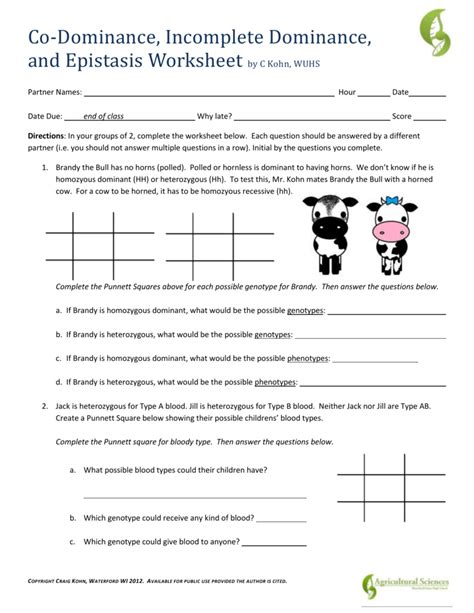Mastering Incomplete Dominance: Free Worksheet and Tips

Understanding Incomplete Dominance

Incomplete dominance is a fascinating phenomenon in genetics where neither of two alleles for a specific trait is completely dominant over the other. Instead of one allele masking the other, the heterozygous phenotype shows an intermediate trait, not fully expressing either of the homozygous phenotypes. This type of inheritance pattern can be observed in many organisms, providing a visual or structural variation that helps us understand genetic diversity better.
What is Incomplete Dominance?

In incomplete dominance, the offspring of parents with different phenotypes exhibit traits that are a blend of both parental traits. A classic example is the snapdragon flower: - The red snapdragon (RR) and white snapdragon (WW) when cross-bred, produce pink snapdragons (RW). Here, the red and white are not blended in the true sense; instead, the heterozygous flower exhibits pink, which is a phenotype in-between red and white.
🧬 Note: Incomplete dominance should not be confused with codominance, where both alleles are expressed simultaneously, like in the ABO blood group system.
How to Identify Incomplete Dominance

Here are the key signs to look for in incomplete dominance:
- The phenotypes of heterozygous individuals are distinct from both homozygous phenotypes.
- The offspring of true-breeding parents show an intermediate trait.
- Phenotypes are not in the typical 3:1 ratio of dominant/recessive inheritance.
Worksheet for Incomplete Dominance

To further solidify your understanding, here is a worksheet you can work through:
| Parent 1 | Parent 2 | Possible Offspring |
|---|---|---|
| RR (Red Snapdragon) | WW (White Snapdragon) | RW (Pink Snapdragon) |
| RW (Pink Snapdragon) | RW (Pink Snapdragon) | RR, RW, WW |
| RW (Pink Snapdragon) | WW (White Snapdragon) | RW, WW |

🧬 Note: For this worksheet, consider the "R" allele as red and "W" as white. Remember that incomplete dominance yields an intermediate phenotype, not a blend.
Examples from Nature

Incomplete dominance is not limited to flowers but occurs in many species:
- Andalusian Fowl: Black and white fowls produce offspring with blue feathers.
- Four O'clock Plants: These plants also show incomplete dominance in their flower colors with red, pink, and white flowers.
- Human Hair Texture: While not a perfect example, hair texture can show incomplete dominance where the offspring of a straight-haired and curly-haired parent might have wavy hair.
Understanding how incomplete dominance works helps us appreciate the intricate mechanisms of genetics. It allows us to see how one gene can influence traits in ways that defy the simple dominant/recessive model.
Practical Tips for Learning Incomplete Dominance

Here are some strategies to better understand and remember the concept of incomplete dominance:
- Visualize: Draw Punnett squares to visually represent genetic outcomes. This can help in visualizing the blend of traits.
- Real Examples: Use real-world examples or engage in activities where you can see the traits firsthand. Observing snapdragons or breeding pet fish can be enlightening.
- Compare and Contrast: Understand how incomplete dominance differs from other inheritance patterns like dominance, codominance, and polygenic inheritance.
- Practice: Use worksheets and online simulations to test your knowledge. Regular practice reinforces concepts.
- Ask Questions: When you encounter any genetic trait, ask yourself if incomplete dominance could be at play.
To sum up, incomplete dominance opens our eyes to the complexity of genetic inheritance. It showcases how even within one gene, there can be intricate mechanisms at work, resulting in phenotypes that aren’t merely black or white but are often shades of gray. By mastering the principles of incomplete dominance, students and enthusiasts alike can deepen their appreciation of genetics, seeing beyond the basic Mendelian inheritance to the fascinating diversity nature provides.
What is the difference between incomplete dominance and codominance?

+
In incomplete dominance, the offspring exhibit an intermediate phenotype of both homozygous parents, like the pink snapdragons. In codominance, both alleles are expressed in the phenotype without blending. For instance, in humans, people with blood group AB have both A and B antigens on their red blood cells.
Can incomplete dominance be seen in human genetics?

+
While it’s not as straightforward in humans, traits like hair texture might exhibit incomplete dominance where parents with different hair types (e.g., straight and curly) can produce offspring with intermediate, wavy hair.
How do you solve genetic problems involving incomplete dominance?

+
To solve problems with incomplete dominance:
- Identify the phenotypes and genotypes of the parents.
- Use Punnett squares to predict the genotypic and phenotypic ratios of the offspring.
- Remember that heterozygous individuals exhibit the intermediate phenotype.



